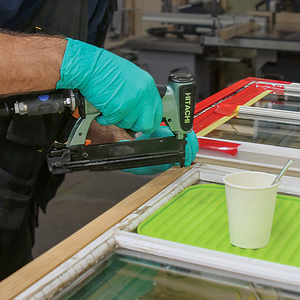background info first.
I work for a landscaping company in eastern CT and the majority of our work takes place on residental properties that contain septic tanks and leach fields. The type of work we perform makes it necessary to use equipment (in our case, Kubota L39) for transporting materials, etc.
When meeting with the HO we try and find out where the septic tank/leach field are located. Some of them know the location, some don’t. For the ones that don’t we ask to see where the pipe exits the house, look for the well (usually opposite side of the house from the tank), take a look at the layout of the property, look for the really green or really dead grass rectangles, etc, etc, etc. Basically we make a real effort to locate it and stay off/ away from the area.
I understand that compaction of soils within the leach field is not good for the system and can cause a decrease in performance or failure.
Working in a yard today and the HO showed us the location of the leach field, very nervous about the tractor crushing pipes, etc. So we stayed as far away as we could without going into neighbors property. Everything went well.
Started thinking about the compaction caused by our tractor tires.
Did some research and found alot of different information regarding what can be driven over a leach field and what can not. The range went from “nothing larger than a small bicycle” to any “tractor under 5000#”. Many other variables were discussed, like what type of system, soil type, age of system, geographic location, etc.
Our backhoe tips the scales at 7000#’s, loaded bucket brings it to 9000#’s(+/-)
Using 9000#’s / 4 tires =2250#’s/tire
Assuming the contact patch on all four tires is equal and all tires are loaded equally (I know this is not the case) and that the contact patch area is 12″x12″ I did some calculations.
12×12=144 sq in/2250# = 15.625#’s/sq in
I’m sure this is not the most accurate way to determine the ground pressure exerted by each tire, but I’d say it gives me a ballpark figure.
For fun I did the same calculations using the small girls bike.
25# bike , 100#kid, 2 tires, 4sq in of tire contact and ended up with 15.625#s!!!!
I know, lots of assumptions and alot of unknowns but I couldn’t believe it. They are the same.
So now the question.
What can/can not be driven over a leach field in your experience?
Aaron



















Replies
Sorry, don't have experience at personally destroying a leach field but do have the benefit of being the victim of a challenged individual operating heavy piece of equipment (JBC backhoe) on a draifield. regarding:
>> 12x12=144 sq in/2250# = 15.625#'s/sq in
I'm sure this is not the most accurate way to determine the ground pressure exerted by each tire, but I'd say it gives me a ballpark figure.
For fun I did the same calculations using the small girls bike.
<< Ok - good analysis... almost. Now, just for the hell of it let's throw in some common sense. Girls bike damage septic field. Yea right!!!! If you think the Kabota is safe, why not let it drive over your foot and tell us if you have a good day. :-) Then, go ahead and try the girls bike,,,
Other than that, the problem is 3 fold: 1) if you F it up with your heavy equipment, you bought it. 2) A 4 tired tractor has a relatively small area over which it spreads it' s weight - admittedly I don't know what a "L 39" is, but for example a bobcat with tires exerts a significantly more amount of psf than say a bobcat with tracks. 3) the damage sometimes doesn't show up for a year or 2 because even if the pipe isn't crushed the soil being compacted is more of a situation that is hard to quantify.
To further complicate things these new septic systems often have the thin corrugated black pipe and the styrofoam peanuts for agrigate. Real strong stuff. ;-) Teh old clay stuff wwasn't any better as far as "crush resistance".
I'd say soil types and the and current soil water retention enters into it also. Obviously sand vs wet cllay have different bearing capisities.
So, in summary there's a lot of variables, but to get the job done fast I'd say go ahead and "ride" on the leach field, but one of these days, be prepaired for a $6,000 back charge.
thanks,
Matt
Thanks for the response and sorry about your bad experience.
"Now, just for the hell of it let's throw in some common sense."
Why didn't you show them the location of the drainfield?
Seems like your problem could have been avoided ;).
Aaron
That was 20 years ago... I signed a contract to buy a house. Septic and well water system had to be inspected by the county. County inspector mandated the installation of a separate geese trap and drain pit for the washer. Guys come in with backhoe and do work. Crushed the pipe that went from the house to the drainfield. All this was un known to me at this point except that I was currious why there was a backhoe in the back yard of the house I was buying :-). The septic tank, which had just been pumped backed up within a few weeks of us moving in. Previous owner refused to fix it. Rather than getting in a big pissing match I had it pumped again, got out a shovel and removed the old pipe - I think it was clay, IIRC, and replaced it with sched 40 PVC.
Edited 11/9/2007 8:26 am ET by Matt
"mandated the installation of a separate geese trap"
Really? I hear those people that live on the lakes in Michigan will pay big bucks for a decent geese trap. How's yours work?
Hey look! I'm not the kind of the type-Os here. Another guy with way more posts than me has got that position all locked up.... :-)
But I recognize a quality typo when I see it! That was a good'un, LOL
Welcome to the Taunton University of Knowledge FHB Campus at Breaktime. where ... Excellence is its own reward!
The 'scapers here have wider floatation tires and don't worry about it.
I asked one of my dirt guys who builds thesse once about this. His answer - "See that dozer I use to build it? Don't drive anything heavier than that on it"
I think there is a lot of validity to your reasoning
Welcome to the
Taunton University of Knowledge FHB Campus at Breaktime.
where ...
Excellence is its own reward!
Piffin,
We have that style of tire on our tractors, the "turf" tire with wide and shallow tread patterns.
They do decrease the amount of damage to the lawn.
Bull dozer?
Now that gets back to the PSI question. A dozer must have a fairly low psi because of the large area that the tracks cover. Making it OK to drive the dozer over the leach field.
Maybe even better than something with 4 tires.
So it's not the weight of the equipment but the type that's more important.
Just thinking out loud.
Obviously, best practice is to stay off.
Thanks for the response.
I have put loaded concrete trucks on mine and not hurt it. just stay away from the tank
just stay away from the tank
We didn't do that once. Or more correctly, we didn't know there had been a previous house on the site.
It's an ugly site to see a concrete truck nose down in a crushed septic tank :(
Dave
I aam sure it has something to do with aggitation too.Around here, all the systems built in the last twenty years are mound type, with infiltrators. so the aggregate is al hauled in and fairly pure. I can see other types in more marginal soils being damaged more easily, LOL, I had one customer very worried about traffic on his, then when we were gone, he had landscapers plant bushes all over the field. I had to explain to him that roots would ruin it far faster than anything else he could do.His reply ?
That's wheere my wife wants those plants so that's where they go!
Welcome to the Taunton University of Knowledge FHB Campus at Breaktime. where ... Excellence is its own reward!
So it's not the weight of the equipment but the type that's more important.
Exactly. I use rubber tired equipment to intentionally compact. Get results that a tracked machine wouldn't.
My 12 ton rubber tired loader is doing a great job compacting a new driveway. One of the reasons I switched from track. Another was that I don't tear up the surface turning, like track does. PAHS Designer/Builder- Bury it!
Whatever psi you have in your tires is the approximate psi applied to the ground.
If the leach field is new (not yet compacted by naural settling), I'd stay off it.
If it is a few year old or older, no fears (unless a swamp built before there were perk tests).
I drive my backhoe 20 psi rear, 90 psi front) and pickup over my lawn a few times a year, no problems others than sometime putting a groove inthe sod if during the really wet season.
(built my own septic tank - 8" concrete with 1/2" rebar mesh, drive on it too, but would not drive on a commercial tank)
In cold country the leach fields are a bit deeper so there is very little that can't be driven over it. We once had a d10 parked on it with no problems.
Having said that, we don't like anything driving over old house plumbing since the old clay pipe is doing it's best to fall apart all on it's own and we don't want an excuse for the client to blame us for it.
Cheers
Beer was created so carpenters wouldn't rule the world.
The typical ground pressure for the front tires of your standard agri tractor is actually about 35-45 psi while the rear tires are about half that. And if you are using bucket fully loaded, it could be even higher on your front tires.
Consider that a D8 has ground pressure of about 10-13 psi.
With that said, your primary concern should be the septic tank since they are usually not at the depth where a point load such as a tire is neglible.
The drain fields backfill is usually compacted well enough too, sometimes with a dozer track or backhoe tire. So that any incidental driving over won't do any damage to the pipe or filter material. And the other factor favoring drainfields is that if they are of sufficient depth, a short term point load will not significantly impact them. " If guns kill people, a spoon made Rosie O'Donnel fat!"